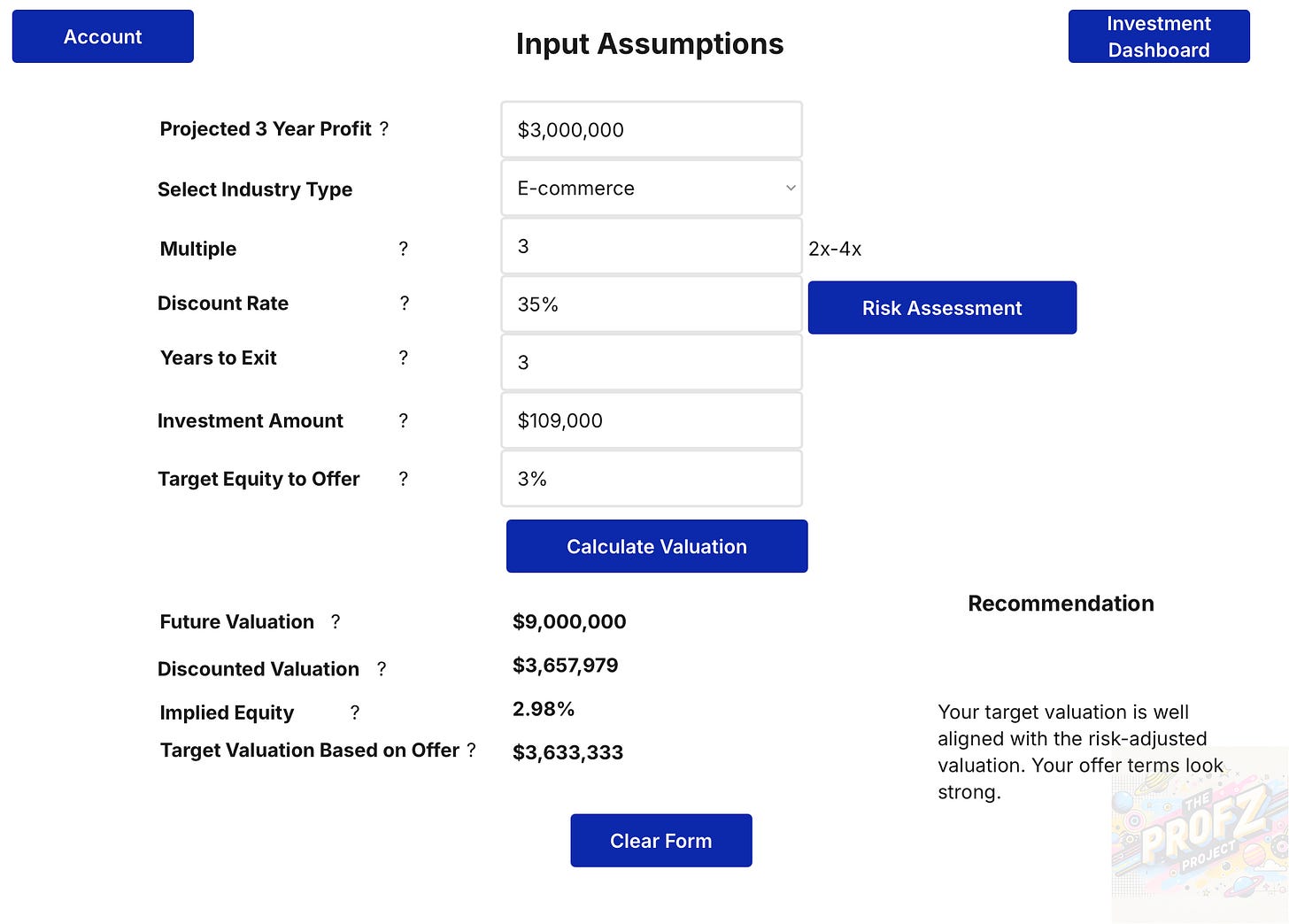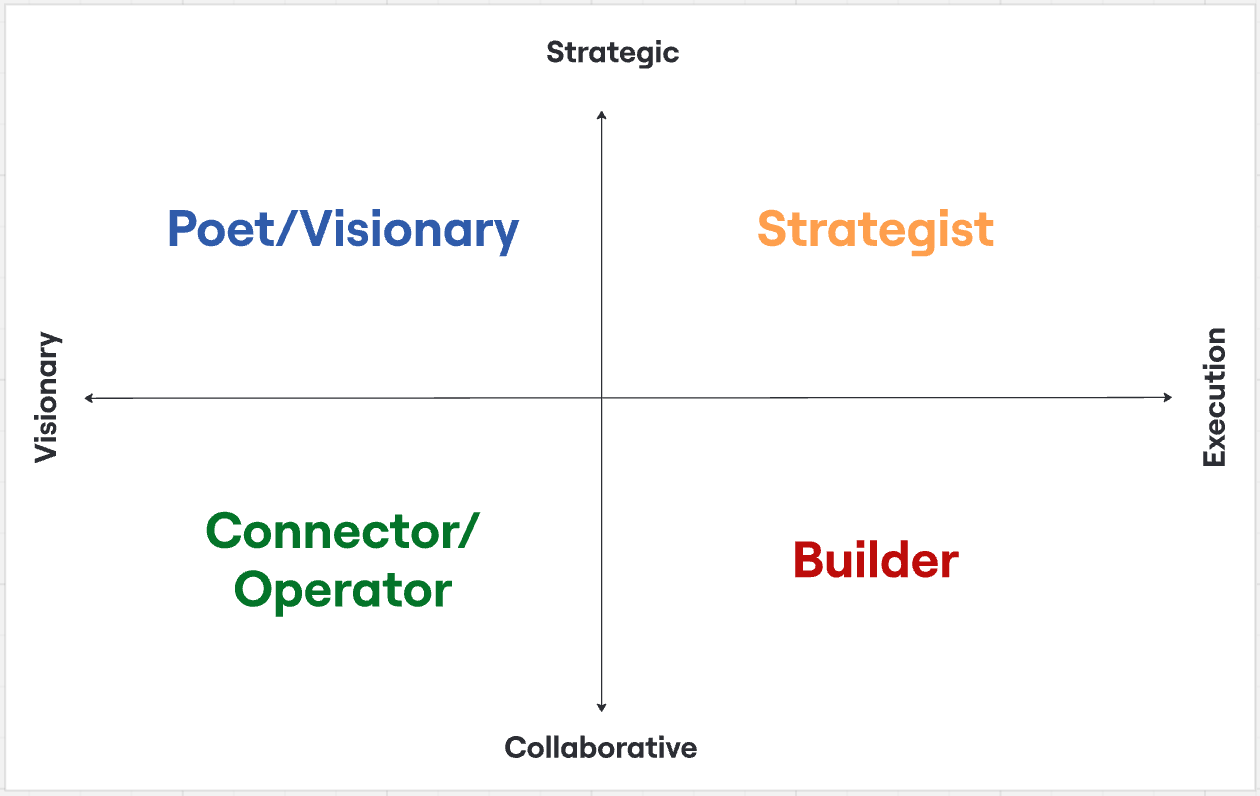Work Archetypes
For a fun experiment in my class, I decided to build a web app.
The idea was simple: simulate a startup investment environment where students acted as investors, allocating virtual dollars to different class startup ideas as each team presented.
I used a no-code platform called Bubble.io, and to my surprise, it was shockingly easy to get started. A few bugs showed up during rollout—because of course they did—but overall, the app worked. Students invested. Startups rose (or fell) based on how much capital they attracted.
During the session, one of my students asked a smart question:
“How do you actually justify your company’s valuation and the equity you’re offering?”
That gave me an idea: what if the app could help students calculate valuations too? So I kept building.
I created a valuation calculator that let users input some basic assumptions: 3-year projected profits, revenue multiple, discount rate, expected years to exit, investment amount, and target equity offer. The calculator then generated:
Future valuation
Discounted present valuation
Implied equity percentage
Target valuation based on the offer
If that sounds like Greek to you—you’re not alone. It did to me a bit too… until I started building. And like any good project, solving one problem uncovered another:
“How do I know what multiple or discount rate to use?”
Good question. That led me to add industry-specific multiples (based on the startup’s sector) and a risk assessment tool to suggest an appropriate discount rate based on the deal’s perceived risk. Through this process, I now have a greater understanding of these concepts and the math behind it.
This Substack is reader-supported. To receive new posts and support my work, consider becoming paid subscriber.
Build to Learn
All of this reminded me of an important lesson:
If you want to truly learn something, build it.
Teaching is a powerful way to deepen knowledge. But building forces you to wrestle with real constraints, expose your blind spots, and discover what you don’t know.
I first learned this early in my career. My first job after the Army was at a small company called Mangan Software Solutions. We were trying to replace old paper processes used by functional safety experts with a digital solution—a field I knew absolutely nothing about.
One of my first assignments? Design a feature that replicated our customer’s manual paperbased safety override procedure. I had no prior expertise or understanding of safety overrides, just a stack of client documents and a deadline.
I dove in—reading everything I could, sketching workflows, and mocking up prototypes. Within a week, I presented a working model that the client loved. We built it, tested it, and shipped it.
It wasn’t just a product win—it was my first real taste of a deeper truth:
The more you build, the more you understand.
That continued throughout my seven years there, building feature after feature until I knew the industry better than many of our clients. Not just what the software did, but why it mattered.
The same pattern has repeated itself during my 2.5 years as a professor. Building content, frameworks, and tools has deepened my understanding far beyond what teaching alone ever could.
The Work Archetypes
As I reflected on the students’ questions and my own learning journey, it struck me again how differently people approach work. Over the years, I’ve come to believe there are four primary work archetypes:
1. The Builder
I’m a Builder. While my degree says “engineer,” I’ve never been an engineer by trade. But I love to build—whether it’s the Prof Z Resource Library, my website, new apps, or system workflows to make processes smoother.
Builders execute. They ship. They refine. They scale.
You’ll often find Builders in roles like:
Product Managers
Engineers or Developers
Project Managers
Operations Managers
But Builders don’t always generate the ideas. For that, they rely on…
2. The Poet / Visionary
Visionaries are the spark. They constantly ask: “What if the world looked different?”
They’re ideators, storytellers, brand builders, and status quo challengers.
Common roles:
Creative Directors
Brand Strategists
Designers
Marketers
Visionaries inspire others to follow—but often need help creating a roadmap.
That’s where they lean on…
3. The Strategist
Once there’s a vision, Strategists get to work: “How do we actually make this happen?”
Strategists see risks, map dependencies, prioritize ruthlessly, and find leverage points.
You’ll often find Strategists as:
BizOps Leaders
CFOs
Corporate Development Leads
Product Strategists
They’re the chess masters—always thinking five moves ahead.
But strategy without execution is just theory, so they partner closely with…
4. The Connector / Operator
Connectors are the glue. They’re natural networkers who get people aligned and moving together.
Connectors shine at talent spotting, building relationships, boosting morale, and influencing even without formal authority
You’ll find them as:
COOs
Chiefs of Staff
HR Leaders
Sales Executives
They are the culture architects—building the teams that build the dream.
Archetype Audit: Find Yours
Wondering which archetype you are? Here’s a simple audit:
1. Audit your energy, not your skills.
What work energizes you—where you lose track of time? You might have skills in coding, but if you dread opening your laptop, you might not actually be a Builder.
2. Watch your default under stress.
When the pressure’s on:
Builders double down on tasks.
Visionaries dream up new paths.
Strategists obsess over the plan.
Connectors bring in allies.
3. Be honest about what you avoid.
Avoidance reveals truth:
Builders avoid endless brainstorming.
Visionaries avoid repetitive execution.
Strategists avoid emotional decisions.
Connectors avoid transactional work.
Where you hesitate points to where you thrive.
4. Ask someone you trust.
We’re often blind to our own tendencies. Ask a peer, manager, spouse, or mentor:
“When I’m at my best, what am I usually doing?”
Their answer will tell you more than any self-assessment quiz ever will.
Final Thought
I don’t expect my app to become a commercial product. That wasn’t the point. But that’s how a lot of great products actually start:
Someone builds something they needed—and discovers others need it too.
If you’re interested in startup valuation, check it out and let me know how it could be better:
Because at the end of the day, building isn’t just how you create products—it’s how you create mastery.
Connect with Zach
Website • Twitter • LinkedIn • Youtube







